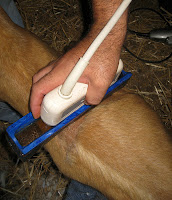 The goats were scanned for ribeye area and backfat thickness using realtime ultrasound on October 3rd by Jim Pritchard from West Virginia University. Jim has considerable experience scanning goats.
The goats were scanned for ribeye area and backfat thickness using realtime ultrasound on October 3rd by Jim Pritchard from West Virginia University. Jim has considerable experience scanning goats.After the data was recorded, it was sent to the Centralized Ultrasound Processing Laboratory (CUP Lab) in Ames, Iowa, for unbiased interpretation.
Ribeye area is the area of the longissimus muscle that is measured between the 12th and 13th rib. The longissimus dorsi is the largest muscle in the body, so ribeye area gives an indication of overall carcass muscling. It is not yet known whether ribeye area is the best indicator of overall carcass muscling in goats.
 Among the 47 goats, ribeye area ranged from 1.01 to 2.28 square inches (6.52 cm2 to 14.71 cm2). The average ribeye area was 1.52 + 0.235 square inches (9.81 cm2).
Among the 47 goats, ribeye area ranged from 1.01 to 2.28 square inches (6.52 cm2 to 14.71 cm2). The average ribeye area was 1.52 + 0.235 square inches (9.81 cm2).The goat with the largest ribeye (by a substantial margin) was a 96-lb. 7/8 Kiko x 1/8 Boer buck consigned by Don Smith. Its ribeye scanned 2.28 in2 (14.71 cm2). Smith also had the goat with the second largest ribeye at 1.97 in2 (12.7 cm2): an 84-lb. 7/8 Kiko x 1/8 Myotonic buck. A 94-lb. 3/4 Kiko x 1/4 Alpine buck consigned by Jeanne Deitz-Band had the third largest ribeye area at 1.94 in2.
Fat thickness, also know as rib fat or back fat, is an external fat measurement taken between the 12th and 13th ribs. In beef cattle, fat thickness influences lean meat yield and is highly related to retail product of a beef carcass.
 However, it is important to note that goats fatten differently than most other livestock. They deposit their fat internally around their organs vs. externally over their bones. A goat with much external backfat is usually a VERY fat goat. As a result, backfat measurements in goats are probably of less significance.
However, it is important to note that goats fatten differently than most other livestock. They deposit their fat internally around their organs vs. externally over their bones. A goat with much external backfat is usually a VERY fat goat. As a result, backfat measurements in goats are probably of less significance.Backfat measurments did not vary significantly among the goats on test. Measurements ranged from 0.04 (1.0 mm) to 0.07 inches (1.8 mm) and averaged 0.053 inches (1.3 mm).
It is important to mention that these data are actual and not adjusted for age or weight. In general, a heavier goat would be expected to have a larger ribeye area.
Download Ultrasound Scan Report











